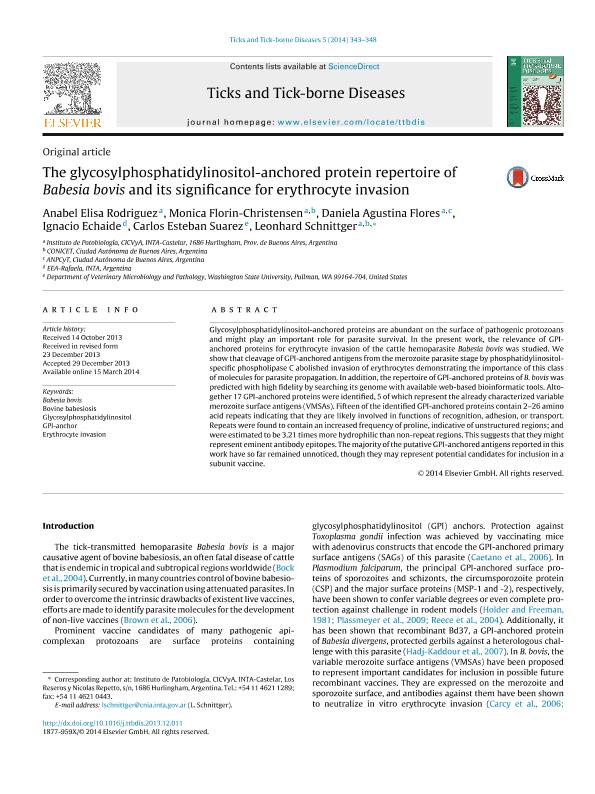Mostrar el registro sencillo del ítem
dc.contributor.author
Rodriguez, Anabel Elisa

dc.contributor.author
Jacobsen, Monica Ofelia

dc.contributor.author
Flores, Daniela Agustina

dc.contributor.author
Echaide, Ignacio Eduardo

dc.contributor.author
Suarez, Carlos Esteban
dc.contributor.author
Schnittger, Leonhard

dc.date.available
2018-02-01T17:24:44Z
dc.date.issued
2014-03
dc.identifier.citation
Rodriguez, Anabel Elisa; Jacobsen, Monica Ofelia; Flores, Daniela Agustina; Echaide, Ignacio Eduardo; Suarez, Carlos Esteban; et al.; The glycosylphosphatidylinositol-anchored protein repertoire of Babesia bovis and its significance for erythrocyte invasion; Elsevier; Ticks and Tick-borne Diseases; 5; 3; 3-2014; 343-348
dc.identifier.issn
1877-959X
dc.identifier.uri
http://hdl.handle.net/11336/35374
dc.description.abstract
Glycosylphosphatidylinositol-anchored proteins are abundant on the surface of pathogenic protozoans and might play an important role for parasite survival. In the present work, the relevance of GPI-anchored proteins for erythrocyte invasion of the cattle hemoparasite Babesia bovis was studied. We show that cleavage of GPI-anchored antigens from the merozoite parasite stage by phosphatidylinositol-specific phospholipase C abolished invasion of erythrocytes demonstrating the importance of this class of molecules for parasite propagation. In addition, the repertoire of GPI-anchored proteins of B. bovis was predicted with high fidelity by searching its genome with available web-based bioinformatic tools. Altogether 17 GPI-anchored proteins were identified, 5 of which represent the already characterized variable merozoite surface antigens (VMSAs). Fifteen of the identified GPI-anchored proteins contain 2–26 amino acid repeats indicating that they are likely involved in functions of recognition, adhesion, or transport. Repeats were found to contain an increased frequency of proline, indicative of unstructured regions; and were estimated to be 3.21 times more hydrophilic than non-repeat regions. This suggests that they might represent eminent antibody epitopes. The majority of the putative GPI-anchored antigens reported in this work have so far remained unnoticed, though they may represent potential candidates for inclusion in a subunit vaccine.
dc.format
application/pdf
dc.language.iso
eng
dc.publisher
Elsevier

dc.rights
info:eu-repo/semantics/openAccess
dc.rights.uri
https://creativecommons.org/licenses/by-nc-nd/2.5/ar/
dc.subject
Babesia Bovis
dc.subject
Bovine Babesiosis
dc.subject
Glycosylphosphatidylinositol
dc.subject
Gpi-Anchor
dc.subject
Erythrocyte Invasion
dc.subject.classification
Otras Ciencias Biológicas

dc.subject.classification
Ciencias Biológicas

dc.subject.classification
CIENCIAS NATURALES Y EXACTAS

dc.title
The glycosylphosphatidylinositol-anchored protein repertoire of Babesia bovis and its significance for erythrocyte invasion
dc.type
info:eu-repo/semantics/article
dc.type
info:ar-repo/semantics/artículo
dc.type
info:eu-repo/semantics/publishedVersion
dc.date.updated
2018-01-30T20:33:40Z
dc.journal.volume
5
dc.journal.number
3
dc.journal.pagination
343-348
dc.journal.pais
Países Bajos

dc.journal.ciudad
Ámsterdam
dc.description.fil
Fil: Rodriguez, Anabel Elisa. Instituto Nacional de Tecnología Agropecuaria. Centro de Investigación en Ciencias Veterinarias y Agronómicas. Instituto de Patobiología; Argentina. Consejo Nacional de Investigaciones Científicas y Técnicas; Argentina
dc.description.fil
Fil: Jacobsen, Monica Ofelia. Consejo Nacional de Investigaciones Científicas y Técnicas; Argentina. Instituto Nacional de Tecnología Agropecuaria. Centro de Investigación en Ciencias Veterinarias y Agronómicas. Instituto de Patobiología; Argentina
dc.description.fil
Fil: Flores, Daniela Agustina. Consejo Nacional de Investigaciones Científicas y Técnicas; Argentina. Instituto Nacional de Tecnología Agropecuaria. Centro de Investigación en Ciencias Veterinarias y Agronómicas. Instituto de Patobiología; Argentina. Ministerio de Ciencia. Tecnología e Innovación Productiva. Agencia Nacional de Promoción Cientifíca y Tecnológica; Argentina
dc.description.fil
Fil: Echaide, Ignacio Eduardo. Instituto Nacional de Tecnología Agropecuaria. Centro Regional Santa Fe. Estación Experimental Agropecuaria Rafaela; Argentina. Consejo Nacional de Investigaciones Científicas y Técnicas; Argentina
dc.description.fil
Fil: Suarez, Carlos Esteban. Washington State University; Estados Unidos
dc.description.fil
Fil: Schnittger, Leonhard. Consejo Nacional de Investigaciones Científicas y Técnicas; Argentina. Instituto Nacional de Tecnología Agropecuaria. Centro de Investigación en Ciencias Veterinarias y Agronómicas. Instituto de Patobiología; Argentina
dc.journal.title
Ticks and Tick-borne Diseases
dc.relation.alternativeid
info:eu-repo/semantics/altIdentifier/doi/http://dx.doi.org/10.1016/j.ttbdis.2013.12.011
dc.relation.alternativeid
info:eu-repo/semantics/altIdentifier/url/https://www.sciencedirect.com/science/article/pii/S1877959X1400034X
Archivos asociados
